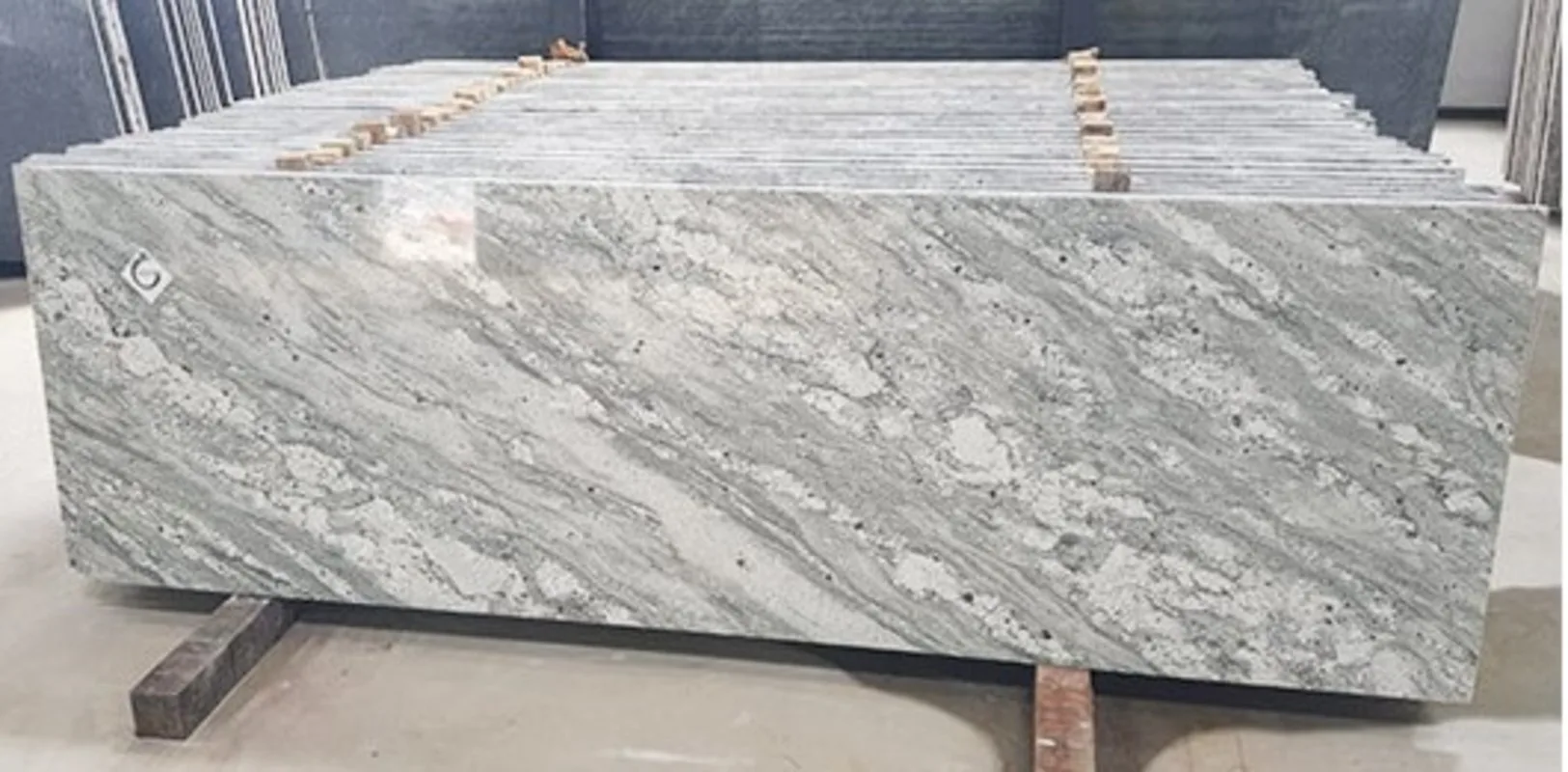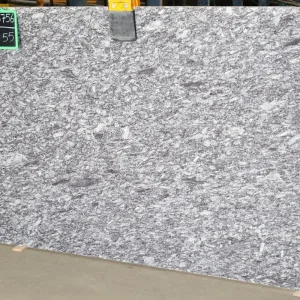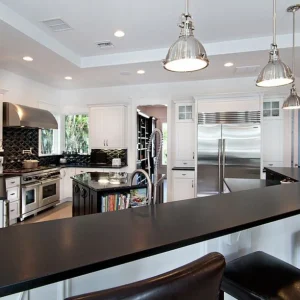Thunder White Granite originates from multiple quarry locations in South India, primarily near Melur in Madurai district (Tamil Nadu) and the Vizag region of Andhra Pradesh. Geologically classified as granulite—a high-grade metamorphic rock formed under intense temperature and moderate pressure conditions—this material is internationally marketed as granite for commercial purposes. Under European Standard application, proper technical documentation must designate this stone as granulite rather than granite, similar to classifications required for other metamorphic dimension stones.
The stone exhibits considerable natural variation in veining patterns and color distribution across different quarry faces. Each slab displays unique characteristics, with grey veining intensity, burgundy garnet distribution, and background tone ranging from pure white to light grey. This variation creates visual interest but requires careful block selection for large commercial projects where pattern consistency matters.
Buyers specify Thunder White for residential kitchen countertops seeking marble-like aesthetics with superior durability, bathroom vanity tops requiring stain resistance, commercial lobby flooring in high-traffic environments, exterior building cladding where frost resistance is essential, landscape paving features, fireplace surrounds, backsplashes, and monumental applications including headstones and commemorative installations. The light color palette coordinates with both contemporary minimalist and traditional design schemes.
Performance and Quality
Thunder White demonstrates performance characteristics suitable for demanding applications. The fine-grained structure and granoblastic texture contribute to excellent polishing characteristics and surface durability. Frost resistance testing confirms suitability for exterior installations in freeze-thaw climates, making it appropriate for cold-region cladding, paving, and outdoor countertop applications where seasonal temperature cycling occurs.
The stone resists heat damage typical of natural granite and granulite materials, withstanding temperatures to approximately 250°C (480°F) without cracking under normal use conditions. However, rapid and extreme localized temperature changes can initiate thermal stress cracking. Users should employ trivets or hot pads for cookware placed directly from heat sources to prevent damage from thermal gradients.
Scratch resistance derives from the hard mineral composition of feldspars and garnets characteristic of high-grade metamorphic rocks. Normal kitchen utensil use will not damage polished surfaces. The material demonstrates chemical resistance to common household cleaners when pH-neutral products are used, though acidic substances should be avoided to prevent etching over time.
Testing indicates a coefficient of friction ranging from 0.4 to 0.6 for leathered finish applications, providing moderate to high slip resistance suitable for flooring where pedestrian safety is a concern. Polished finishes offer less slip resistance and require appropriate application in dry interior environments or with anti-slip treatment for stair and high-moisture installations.
Materials and Construction
Granulite forms through high-temperature metamorphism of pre-existing rocks under conditions typically found at significant crustal depth. The process creates medium to coarse-grained rocks mainly composed of feldspars, sometimes associated with quartz and anhydrous ferromagnesian minerals. The distinctive burgundy garnets visible in Thunder White result from specific pressure-temperature conditions during metamorphic crystallization.
The granoblastic texture—characterized by interlocking mineral grains of approximately equal size—provides structural integrity and excellent polishing characteristics. Granulites are closely allied to gneisses but differ in grain size (finer), foliation perfection (less developed), and garnet content (more frequent).
During fabrication, manufacturers may apply clear epoxy resin filler to micro-fissures or minor surface pitting during polishing. This treatment provides a smoother finished surface without compromising structural integrity or affecting performance under normal use conditions. No color enhancers are used in quality production, ensuring the stone’s natural appearance remains authentic.
Parameter |
Description |
| Slab Sizes | Gangsaw 280 x 180 CM up in 2, 3 CM, and other Cutter Slabs: 180 x 60 CM up in 2, 3 CM, and other |
| Tiles | 30×30, 30×60, 40×40, 60×40, 60×60, 60 x 90, 60×120 CM in various thicknesses and custom sizes |
| Thickness | 6 mm, 18 mm, 20 mm, 30 mm & custom options |
| Others | Window sills, thresholds, monuments, steps & treads, flagstones, and articles available in custom sizes |
| Finishes | Flamed, Polished, Lapotra, Honed, Brushed, Leather, Antique, Bush Hammered and Shot Blast |
| Place of Origin | South India |
Maintenance and Care
Thunder White requires straightforward maintenance suitable for busy residential and commercial environments. Daily cleaning needs only mild soap and warm water applied with soft cloth or microfiber mop. Avoid harsh chemicals, acidic cleaners (vinegar, citrus-based products, wine), or abrasive scrubbers that can etch or dull the polished finish.
Address spills promptly, particularly from coffee, tea, oils, and colored beverages. While granulite demonstrates good stain resistance, proper sealing enhances protection. Before applying penetrating sealer, test a small sample section—excessive sealing attempts on dense granulite may create residue film buildup rather than beneficial penetration. When sealing is appropriate, apply quality impregnating sealer annually for countertops and every 2-3 years for flooring.
For kitchen countertops, establish routine of wiping surfaces after food preparation and using cutting boards to minimize direct contact with acidic foods. For flooring installations, daily dust mopping and weekly damp mopping with neutral cleaner maintain appearance. High-traffic commercial flooring benefits from professional deep cleaning annually with extraction equipment.
Expected service life for interior countertops ranges from 25 to 50+ years with proper maintenance. Flooring and exterior cladding typically provide 50 to 100+ years of functional performance based on documented performance of high-grade metamorphic dimension stones in infrastructure applications.
Installation and Compatibility
Professional installation by experienced stone fabricators ensures optimal results and warranty coverage. Thunder White’s fine-grained structure and moderate hardness allow efficient fabrication with standard diamond tooling. Countertop installation requires diamond-blade wet saws, CNC routing equipment for sink cutouts, and vacuum suction systems for slab handling.
For countertop installations, fabricators create precise template measurements, cut slabs to specification, polish edges to desired profile, and install using appropriate adhesives rated for natural stone. Installation typically takes 1-3 days for standard residential kitchen configurations. For flooring, use modified thin-set mortar specifically rated for natural stone over properly prepared substrate with appropriate waterproofing where moisture exposure occurs.
Grout selection significantly affects final appearance. Light grey, warm beige, or soft white grout harmonizes with the stone’s natural palette, while contrasting dark grey emphasizes individual tile boundaries. Epoxy grout provides superior stain resistance for kitchen backsplashes and commercial food-service areas.
Exterior cladding systems should incorporate mechanical anchoring per ASTM C1242 guidelines rather than adhesive-only methods, particularly in seismic zones or freeze-thaw climates. Consult structural engineers for specific anchoring load calculations on facades exceeding 15 meters in height or in high-wind coastal environments.
Pros & Cons
Advantages
- Marble aesthetics with granite durability: White to light grey base with veining mimics marble appearance while providing superior scratch and stain resistance
- Frost resistance verified: Documented performance in freeze-thaw environments suitable for cold-climate exterior cladding, paving, and outdoor applications
- Slip resistance in textured finishes: Coefficient of friction 0.4-0.6 (leathered) provides safety for flooring installations
- Versatile design compatibility: Light neutral palette coordinates with contemporary minimalist, traditional, and transitional interior styles
Considerations
- High color variation: Veining and garnet distribution vary considerably between slabs; same-quarry-face block selection required for uniform projects
- European nomenclature requirements: Must be specified as “granulite” (not granite) in EU/EN standard jurisdictions, affecting specification compliance
- Sealing sensitivity: Dense composition may develop residue buildup from excessive sealing; requires sample testing before application
Who Should Buy
Ideal Buyers
- Residential renovators seeking marble-like aesthetics with superior durability and lower maintenance for kitchen and bathroom projects
- Commercial architects specifying exterior cladding for cold-climate buildings requiring frost-resistant natural stone
- Hospitality developers needing light, neutral stone for lobby flooring that withstands heavy traffic with proper slip resistance
- Landscape architects designing outdoor kitchens, patio countertops, or hardscape features in regions with freeze-thaw cycles
- Monument fabricators requiring durable light-colored stone with distinctive natural character for memorials and commemorative installations
Not Recommended For
- Projects requiring perfectly uniform, no-variation stone with consistent color across all slabs (consider engineered quartz instead)
- Buyers seeking deeply saturated white appearance with zero grey veining (consider pure white marble or quartz)
- EU/EN standard projects where specifiers cannot accommodate granulite classification requirements in documentation
- Ultra-modern designs preferring solid black, dark grey, or bold-veined dramatic patterns
- DIY installers without access to diamond tooling and professional stone fabrication equipment
FAQs
Q1: What is the difference between granulite and granite, and why does Thunder White’s classification matter?
Granulite is a high-grade metamorphic rock formed under intense heat and moderate pressure, while granite is an igneous rock formed from cooled magma. Thunder White performs comparably to granite but must be specified as “granulite” in European Standard applications for regulatory compliance. This affects project documentation in EU jurisdictions but does not indicate inferior performance.
Q2: How does Thunder White compare to River White Granite—are they the same stone?
Thunder White and River White are related but distinct varieties. Both feature white bases with burgundy accents, but Thunder White (granulite from Tamil Nadu/Andhra Pradesh) exhibits finer grain structure and more varied grey veining, while River White (granite from Andhra Pradesh) shows more uniform pattern with bounded appearance. They are often considered synonymous in commercial markets.
Q3: Can Thunder White be used for outdoor kitchen countertops in cold climates?
Yes. Thunder White demonstrates documented frost resistance suitable for freeze-thaw environments. The granulite structure withstands seasonal temperature cycling without deterioration. Proper sealing with quality penetrating sealer and routine maintenance ensure long-term outdoor performance.
Q4: How should I clean tea and coffee stains on Thunder White countertops?
For fresh stains, wipe immediately with damp cloth and mild dish soap. For set stains, create paste of baking soda and water, apply to stain, cover with plastic wrap for 24 hours, then wipe clean. Avoid acidic cleaners. Proper annual sealing prevents most staining issues.
Q5: What thickness should I choose for Thunder White kitchen countertops?
Minimum thickness is typically 2cm (3/4 inch) for standard residential countertops. Many homeowners prefer 3cm (1-1/4 inch) for added durability, more substantial appearance, and reduced need for substrate support. Thickness choice depends on personal preference, budget, and specific usage requirements.
Q6: Does Thunder White require sealing immediately after installation?
Test first with a small sample. While granulite generally benefits from sealing, excessive application on dense Thunder White blocks may create surface residue buildup rather than beneficial penetration. If water beads on the surface for 5+ minutes without soaking in, sealing frequency can be reduced. When appropriate, apply impregnating (not topical) sealer.








